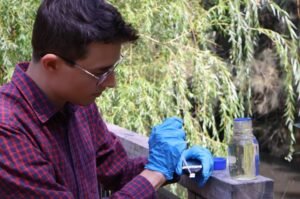Friday, 16 January 2026
Korea fosters growth of seaweed industry
The wholesale price of 100 sheets of dried laver reached 10,440 won ($7.5), marking a steep 58 per cent increase from 6,628 won a year earlier The price of processed…

The wholesale price of 100 sheets of dried laver reached 10,440 won ($7.5), marking a steep 58 per cent increase from 6,628 won a year earlier
The price of processed laver sheets, or papery thin sheets of edible seaweed, surged by almost 60 per cent in April, primarily fueled by the escalating demand for Korean cuisine abroad, particularly for gimbap and seaweed-wrapped rice. The wholesale price of 100 sheets of dried laver reached 10,440 won ($7.5), marking a steep 58 per cent increase from 6,628 won a year earlier. Moreover, the average retail price for a single sheet of seaweed surpassed 130 won.
This significant price spike is primarily attributed to the upsurge in seaweed exports. Between October 2023 and the second week of April 2024, a staggering 143.8 million tonnes of seaweed were harvested, indicating a notable 6.1 per cent surge compared to the previous year.
According to a recent World Bank report, Korea ranks among the top three largest seaweed producers globally. The Republic of Korea’s government is actively fostering the growth of its seaweed industry, aiming for an export-driven food industry valued at $750 million by 2024. In recent years, Korea has witnessed industry expansion through the adoption of technologies that enhance productivity. These technologies span various segments of the industry, from strain selection to hatchery and growing techniques, as well as harvesting and processing.
There exists significant potential for many developing nations in Africa and Southeast Asia, endowed with substantial coastal areas, to enter the market and capitalise on the burgeoning demand in this sector. However, besides facing financial constraints, these countries lack the necessary technology and expertise to strategically invest in the seaweed sector. While seaweed farming presents itself as a cost-effective, sustainable, and innovative solution with the capacity to address multiple pressing challenges, its development necessitates investments from both the private and public sectors.
To address these challenges, the Korea-World Bank Partnership Facility (KWPF) has sanctioned a grant titled “Korean Technology and Knowledge Transfer to Transform the Seaweed Agribusiness in Africa and Southeast Asia.” This grant aims to bolster the development of the AquaInvest Platform, supported by PROBLUE, which constitutes a collaborative effort among World Bank Group teams, clients, and partners. The primary objective of this grant initiative is to enhance understanding of seaweed and spur seaweed investments in selected Asian and African countries.
Seaweed, encompassing a variety of plant and algae species that thrive in oceans, lakes, and rivers, plays a crucial ecological role, according to the National Ocean Service (NAS). These plants, classified as macroalgae, are characterised by containing chlorophyll and are typically categorized into three groups: green algae (Chlorophyta), brown algae (ochrophyta, Phaeophyceae), and red algae (Rhodophyta).
In contrast to conventional weeds that proliferate rapidly and can disrupt their surrounding ecosystems, seaweed serves as a fundamental element of marine life. It serves as sustenance and refuge for numerous organisms, constituting a vital component of a healthy aquaculture, as the NAS highlights.
While less ubiquitous in Western cultures, seaweed has been a dietary staple for millennia, particularly among communities residing along coastlines. A study published in Nutrition Reviews revealed that one-fifth of meals consumed in Japan incorporate some form of edible seaweed.
Edible seaweed is a common dietary ingredient in many Asian countries, particularly in Korea, Japan and China. The Food and Agriculture Organization of the United Nations states that China is the largest producer of edible seaweed, followed by Korea and Japan. However, commercial seaweed harvesting occurs in 35 countries worldwide, with varying climates ranging from cold to tropical. Apart from Asia, seaweed consumption is also popular in Ireland and Canada, and it is becoming increasingly popular in some parts of the United States and South America.
Technology
Bringing PFAS testing to the point of need
Jan 16, 2026 | Australia
Study finds Magtein enhances memory, reaction time and heart health markers
Jan 15, 2026 | Company News
Walmart and Google turn AI discovery into effortless shopping experiences
Jan 15, 2026 | Company News
Food Testing
Bringing PFAS testing to the point of need
Jan 16, 2026 | Australia
IMCD opens a Food & Nutrition Laboratory in Cologne
Jan 08, 2026 | Company News
La Trobe University Develops Portable Biosensor to Detect PFAS in Water
Jan 08, 2026 | Australia
More Popular
Amar Pure Gold to invest Rs 250 Cr in Agro-Food Park in Himachal Pradesh
Jan 16, 2026 | Company News
Franke launches new A Line in Southeast Asia and opens regional flagship showroom in Singapore
Jan 16, 2026 | Beverages
EXBERRY plant-based colour supplier GNT earns top sustainability award
Jan 16, 2026 | Awards





